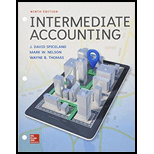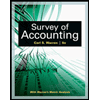
Concept explainers
(1)
Financial Statements: Financial statements are condensed summary of transactions communicated in the form of reports for the purpose of decision making. The financial statements reports, and shows the financial status of the business. The financial statements consist of the
Financial Disclosures: Financial disclosures refer to all material, significant and relevant information about the reporting organization that are essential to understand the financial statements of the organization entirely. It also helps to evaluate the performance and the financial health of an organization. These disclosures are either provided on the face of the financial statement or as notes to the financial statements as supporting schedules.
GAAP:
Generally Accepted Accounting Principle (GAAP) is a common set of accounting principles, standards, and procedures that the companies must follow at the time of preparation of the financial statements.
IFRS:
International Financial Reporting Standard is abbreviated as IFRS. The IFRS is set up to bring a standard global language in accounting, so that the other firms across the globe can understand the accounting term of all other businesses.
Rules of Debit and Credit:
Following rules are followed for debiting and crediting different accounts while they occur in business transactions:
- Debit all increase in assets, expenses and dividends, all decrease in liabilities, revenues and stockholders’ equities.
- Credit all increase in liabilities, revenues, and stockholders’ equities, and all decrease in assets and expenses.
To determine: The reason for increase in total deferred income of €249 as of the end of fiscal 2015. \
(2)
To explain: the threshold for recognition of provision under IFRS different than it is under U.S. GAAP.
(3)(a)
Beginning and ending balances of total provisions and retirement benefits shown in Note 32 for fiscal 2015 tie to the balance sheet.
b.
To prepare:
(4)
To know: Whether amounts of
Want to see the full answer?
Check out a sample textbook solution
Chapter 13 Solutions
INTERMEDIATE ACCOUNTING(LL)-W/2 ACCESS
- PLEASE HELParrow_forwardOne company might depreciate a new computer over three years while another company might depreciate the same model computer over five years...and both companies are right. True Falsearrow_forwardno chatgpAccumulated Depreciation will appear as a deduction within the section of the balance sheet labeled as Property, Plant and Equipment. True Falsearrow_forward
- No ai Depreciation Expense is shown on the income statement in order to achieve accounting's matching principle. True Falsearrow_forwardno aiOne company might depreciate a new computer over three years while another company might depreciate the same model computer over five years...and both companies are right. True Falsearrow_forwardno ai An asset's useful life is the same as its physical life? True Falsearrow_forward
- no ai Depreciation Expense reflects an allocation of an asset's original cost rather than an allocation based on the economic value that is being consumed. True Falsearrow_forwardThe purpose of depreciation is to have the balance sheet report the current value of an asset. True Falsearrow_forwardDepreciation Expense shown on a company's income statement must be the same amount as the depreciation expense on the company's income tax return. True Falsearrow_forward
 Survey of Accounting (Accounting I)AccountingISBN:9781305961883Author:Carl WarrenPublisher:Cengage Learning
Survey of Accounting (Accounting I)AccountingISBN:9781305961883Author:Carl WarrenPublisher:Cengage Learning
